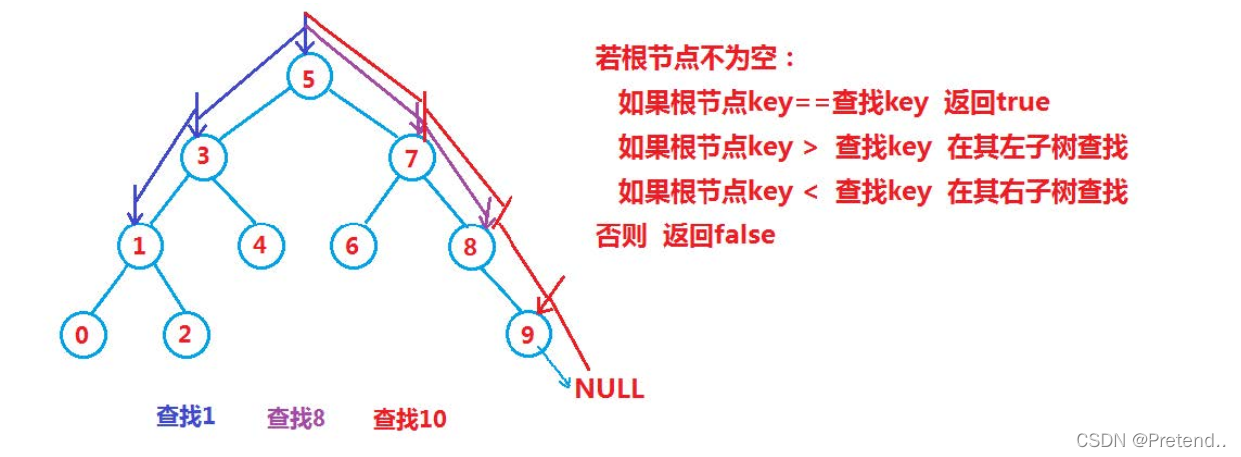目录
1、为什么要引入Map和Set
Map和Set是专门用来搜索的数据结构。常见的搜索方式如下:
- 直接查找:时间复杂度O(N),元素比较多时效率慢
- 二分查找:时间复杂度O(log(2)N),搜索前要求集合有序
上述类型的查找比较适合静态查找(一般不会对区间进行插入和删除操作),如果在查找时进行一些插入和删除操作,上面两种方式就不太合适。Map和Set就是一种适合动态查找的集合容器。
2、Map
Map是一个接口类,该类没有继承Collection,该类中存储的是<K,V>结构的键对值,K的值一定是唯一的,不能重复的。
(1)Map的常用方法
| 方法 | 解释 |
| V get(Object key) | 返回 key 对应的 value |
| V getOrDefault(Object key, V defaultValue) | 返回 key 对应的 value,key 不存在,返回默认值 |
| V put(K key, V value) | 设置 key 对应的 value |
| V remove(Object key) | 删除 key 对应的映射关系 |
| Set<K> keySet() | 返回所有 key 的不重复集合 |
| Collection<V> values() | 返回所有 value 的可重复集合 |
| Set<Map.Entry<K, V>> entrySet() | 返回所有的 key-value 映射关系 |
| boolean containsKey(Object key) | 判断是否包含 key |
| boolean containsValue(Object value) | 判断是否包含 value |
注:
- Map是一个接口,不能直接实例化对象。只能实例化TreeMap或HashMap。
- Map中存放的Key是唯一的,value是可以重复的(如果重复,存放最新的val值)
- HashMap可以存放null,TreeMap不可以。
- Map中的Key可以全部分离出来,存储在Set中访问
- Map中的value可以全部分离出来,存储在Collection的任何一个子集合中
(2)Map.Entry<K,V>
Map.Entry<K, V> 是Map内部实现的用来存放<key, value>键值对映射关系的内部类,该内部类中主要提供了<key, value>的获取,value的设置以及Key的比较方式。
| 方法 | 解释 |
| K getKey() | 返回 entry 中的 key |
| V getValue() | 返回 entry 中的 value |
| V setValue(V value) | 将键值对中的value替换为指定value |
注:Map.Entry<K,V>并没有提供设置Key的方法
(3)模拟实现HashMap【OJ链接】
底层使用单向链表来实现HashMap
class Node{
public int key;
public int value;
public Node next;
public Node(int key,int value){
this.key=key;
this.value=value;
}
}
class MyHashMap {
public Node root;
public MyHashMap() {
}
public void put(int key, int value) {
if(root==null){
root=new Node(key,value);
return;
}
Node cur=root;
Node prev=null;
while(cur!=null){
if(cur.key==key){
cur.value=value;
return;
}
prev=cur;
cur=cur.next;
}
prev.next=new Node(key,value);
}
public int get(int key) {
Node cur=root;
while(cur!=null){
if(cur.key==key){
return cur.value;
}
cur=cur.next;
}
return -1;
}
public void remove(int key) {
if(root==null){
return;
}
if(root.key==key){
root=root.next;
return;
}
Node cur=root.next;
Node prev=root;
while(cur!=null){
while(cur.key==key){
prev.next=cur.next;
return;
}
prev=cur;
cur=cur.next;
}
}
}3、Set
Set和Map主要有两点不同:Set是继承自Collection的接口类,Set中只存储了key值。
(1)Set的常用方法
| 方法 | 解释 |
| boolean add(E e) | 添加元素,但重复元素不会被添加成功 |
| void clear() | 清空集合 |
| boolean contains(Object o) | 判断 o 是否在集合中 |
| Iterator<E> iterator() | 返回迭代器 |
| boolean remove(Object o) | 删除集合中的 o |
| int size() | 返回set中元素的个数 |
| boolean isEmpty() | 检测set是否为空,空返回true,否则返回false |
| Object[] toArray() | 将set中的元素转换为数组返回 |
| boolean containsAll(Collection<?> c) | 集合c中的元素是否在set中全部存在,是返回true,否则返回 false |
| boolean addAll(Collection<? extends E> c) | 将集合c中的元素添加到set中,可以达到去重的效果 |
注:
- Set中只存储了key值,要求key值唯一
- Set最大的功能是给集合中元素去重
- Set中不能插入为null的key
- Set中的key值不能修改
- Set的底层是用Map来实现的,使用key和Object的一个默认对象作为键值对插入到Map中
(2)模拟实现HashSet【OJ链接】
使用双向链表来模拟实现HashSet,注意Set是对集合进行去重,所以在添加元素时,如果集合中已经存在,则不需要添加。
class Node{
public int key;
public Node next;
public Node(int key){
this.key=key;
}
}
class MyHashSet {
public Node front;
public Node rear;
public MyHashSet() {
}
public void add(int key) {
if(front==null){
front=new Node(key);
rear=front;
return;
}
Node cur=front;
//添加之前需要先去重,如果Set中存在这个值,则不需要插入
while(cur!=null){
if(cur.key==key){
return;
}
cur=cur.next;
}
rear.next=new Node(key);
rear=rear.next;
}
public void remove(int key) {
Node cur=front;
Node prev=null;
while(cur!=null){
if(cur.key==key){
if(cur==front){
front=front.next;
}else if(cur==rear){
prev.next=null;
rear=prev;
}else{
prev.next=cur.next;
}
return;
}
prev=cur;
cur=cur.next;
}
}
public boolean contains(int key) {
if(front==null){
return false;
}
Node cur=front;
while(cur!=null){
if(cur.key==key){
return true;
}
cur=cur.next;
}
return false;
}
}4、二叉搜索树
二叉搜索树又称二叉排序树:
- 左子树不为空时,左子树所有节点小于根节点
- 右子树不为空时,右子树所有节点都大于根节点
- 左右子树也为二叉搜索树
(1)查找

public boolean search(int val){
Node1 cur=this.root;
while(cur!=null){
if(cur.val==val){
return true;
}else if(cur.val>val){
cur=cur.left;
}else{
cur=cur.right;
}
}
return false;
}(2)插入
- 如果树为空,直接插入到根节点

- 如果树不为空,找到合适的位置插入(插入的节点的父节点左右子树一定都为空)

public boolean insert(int val){
if(this.root==null){
root=new Node1(val);
return true;
}
Node1 cur=this.root;
Node1 parent=null;
while(cur!=null){
if(cur.val==val){
return false;
}else if(cur.val>val){
parent=cur;
cur=cur.left;
}else{
parent=cur;
cur=cur.right;
}
}
if(parent.val>val){
parent.left=new Node1(val);
}else{
parent.right=new Node1(val);
}
return true;
}(3)删除(重点)
设待删除结点为 cur, 待删除结点的双亲结点为 parent。
1. cur.left == null
- 1. cur 是 root,则 root = cur.right
- 2. cur 不是 root,cur 是 parent.left,则 parent.left = cur.right
- 3. cur 不是 root,cur 是 parent.right,则 parent.right = cur.right
2. cur.right == null
- ?cur 是 root,则 root = cur.left
- ?cur 不是 root,cur 是 parent.left,则 parent.left = cur.left
- ?cur 不是 root,cur 是 parent.right,则 parent.right = cur.left
3. cur.left != null && cur.right != null
? ? ?左右子树都不为空时,使用替换法删除,找到右子树中最小的节点(target),用它的值填补待删除的节点的值,最后只需要删除节点target即可。
//二叉树的删除
public boolean remove(int val){
if(this.root==null){
return false;
}
Node1 cur=this.root;
Node1 parent=null;
while(cur!=null){
if(cur.val==val){
removeChild(parent,cur);
return true;
}else if(cur.val>val){
parent=cur;
cur=cur.left;
}else{
parent=cur;
cur=cur.right;
}
}
return false;
}
//删除
public void removeChild(Node1 parent,Node1 cur){
if(cur.left==null){
if(cur==root){
root=root.right;
}else if(cur==parent.left){
parent.left=cur.right;
}else if(cur==parent.right){
parent.right=cur.right;
}
}else if(cur.right==null){
if(cur==root){
root=root.left;
}else if(cur==parent.left){
parent.left=cur.left;
}else if(cur==parent.right){
parent.right=cur.left;
}
}else if(cur.left!=null&&cur.right!=null){
Node1 target=cur.right;
Node1 targetParent=null;
while(target.left!=null){
targetParent=target;
target=target.left;
}
cur.val=target.val;
if(target==cur.right){
cur.right=target.right;
}else{
targetParent.left=target.right;
}
}
}